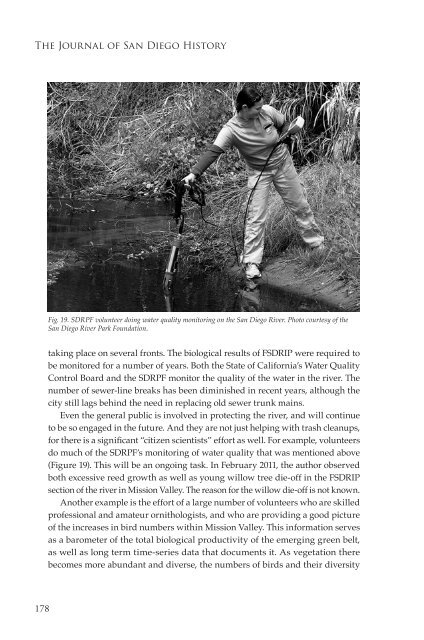Summer 2011, Volume 57, Number 3 - San Diego History Center
Summer 2011, Volume 57, Number 3 - San Diego History Center
Summer 2011, Volume 57, Number 3 - San Diego History Center
Create successful ePaper yourself
Turn your PDF publications into a flip-book with our unique Google optimized e-Paper software.
The Journal of <strong>San</strong> <strong>Diego</strong> <strong>History</strong><br />
Fig. 19. SDRPF volunteer doing water quality monitoring on the <strong>San</strong> <strong>Diego</strong> River. Photo courtesy of the<br />
<strong>San</strong> <strong>Diego</strong> River Park Foundation.<br />
taking place on several fronts. The biological results of FSDRIP were required to<br />
be monitored for a number of years. Both the State of California’s Water Quality<br />
Control Board and the SDRPF monitor the quality of the water in the river. The<br />
number of sewer-line breaks has been diminished in recent years, although the<br />
city still lags behind the need in replacing old sewer trunk mains.<br />
Even the general public is involved in protecting the river, and will continue<br />
to be so engaged in the future. And they are not just helping with trash cleanups,<br />
for there is a significant “citizen scientists” effort as well. For example, volunteers<br />
do much of the SDRPF’s monitoring of water quality that was mentioned above<br />
(Figure 19). This will be an ongoing task. In February <strong>2011</strong>, the author observed<br />
both excessive reed growth as well as young willow tree die-off in the FSDRIP<br />
section of the river in Mission Valley. The reason for the willow die-off is not known.<br />
Another example is the effort of a large number of volunteers who are skilled<br />
professional and amateur ornithologists, and who are providing a good picture<br />
of the increases in bird numbers within Mission Valley. This information serves<br />
as a barometer of the total biological productivity of the emerging green belt,<br />
as well as long term time-series data that documents it. As vegetation there<br />
becomes more abundant and diverse, the numbers of birds and their diversity<br />
178







![[PDF] The Journal of San Diego History Vol 52: Nos 1 & 2](https://img.yumpu.com/25984149/1/172x260/pdf-the-journal-of-san-diego-history-vol-52-nos-1-2.jpg?quality=85)

![[PDF] The Journal of San Diego History - San Diego History Center](https://img.yumpu.com/25984131/1/172x260/pdf-the-journal-of-san-diego-history-san-diego-history-center.jpg?quality=85)







